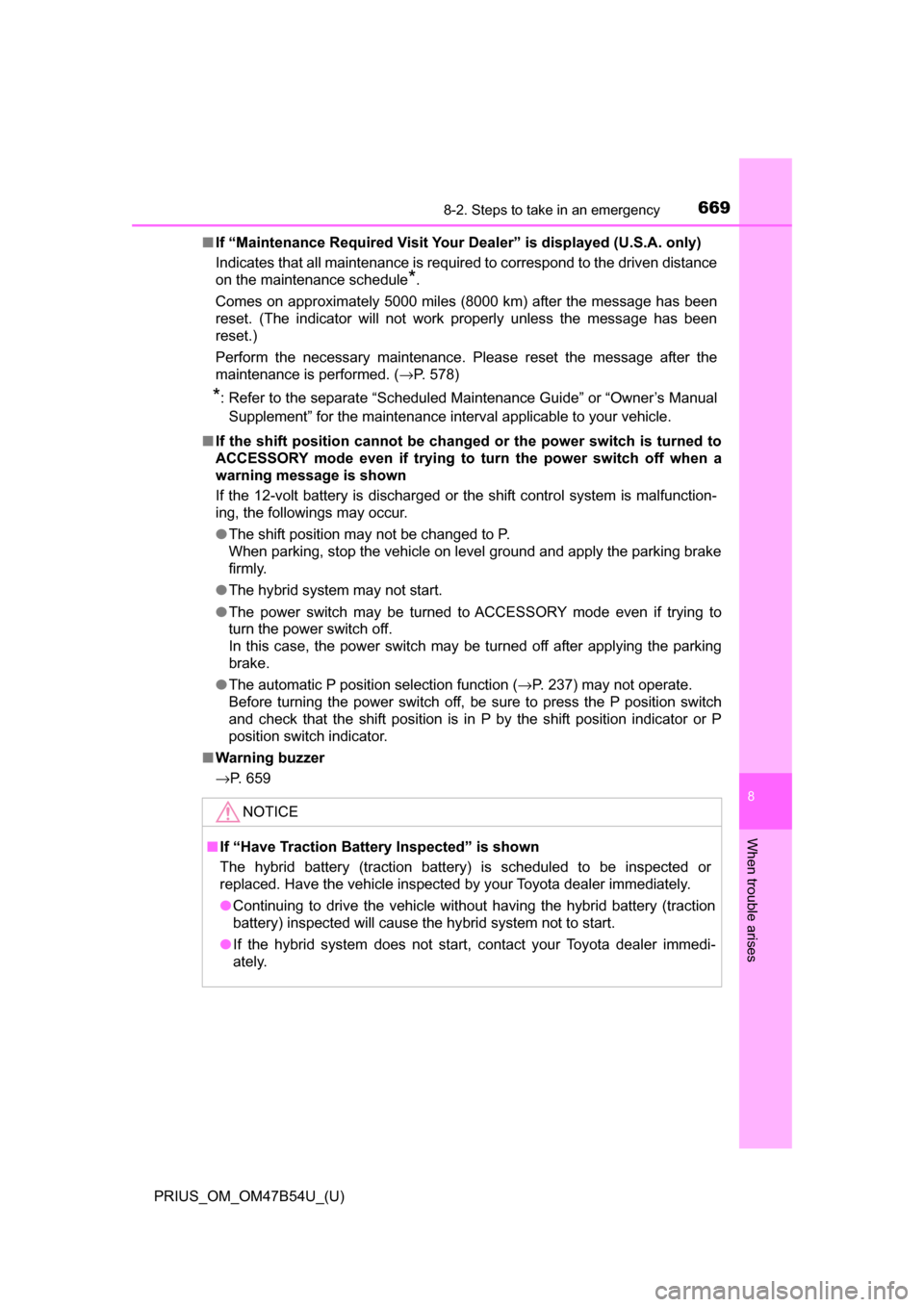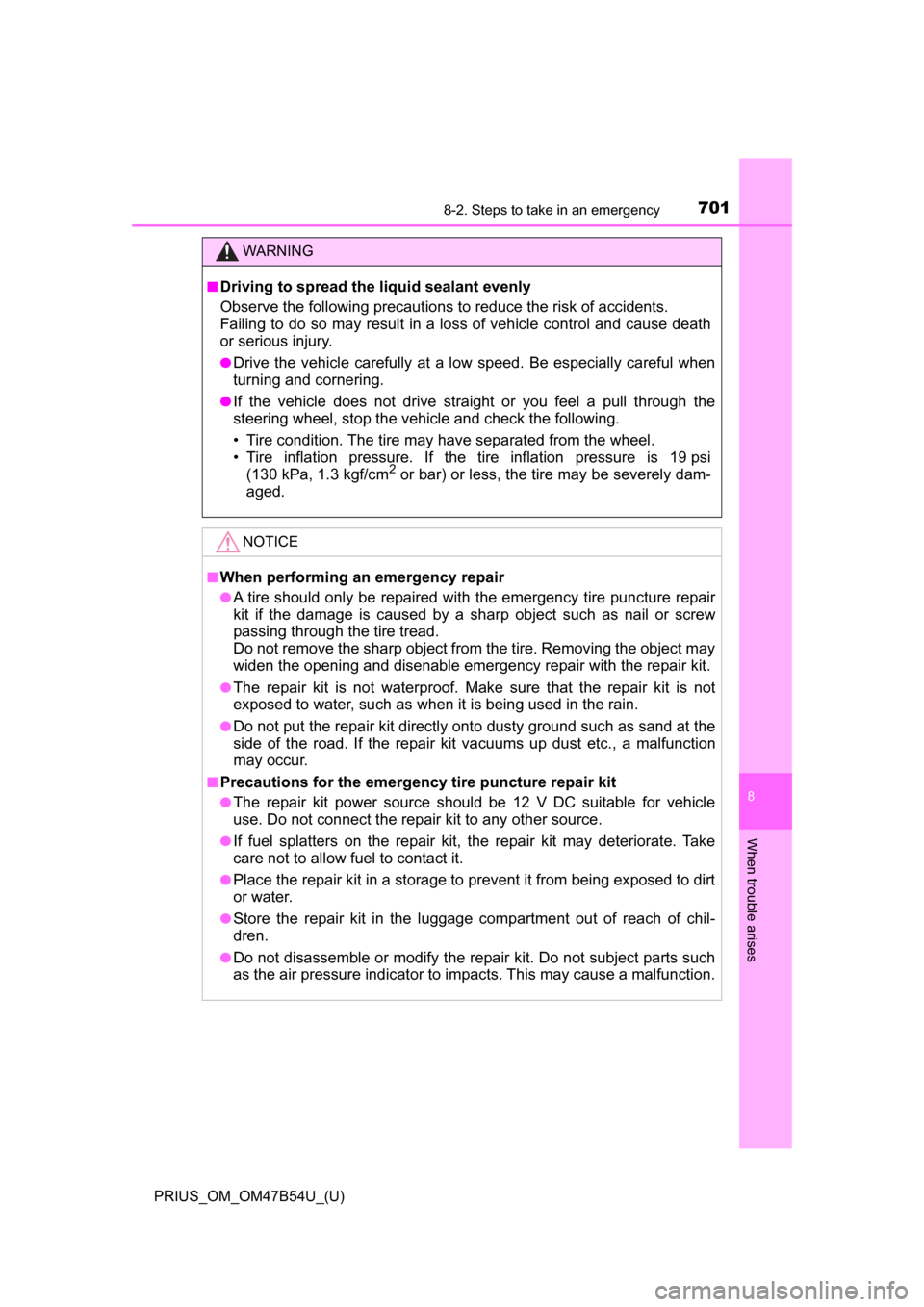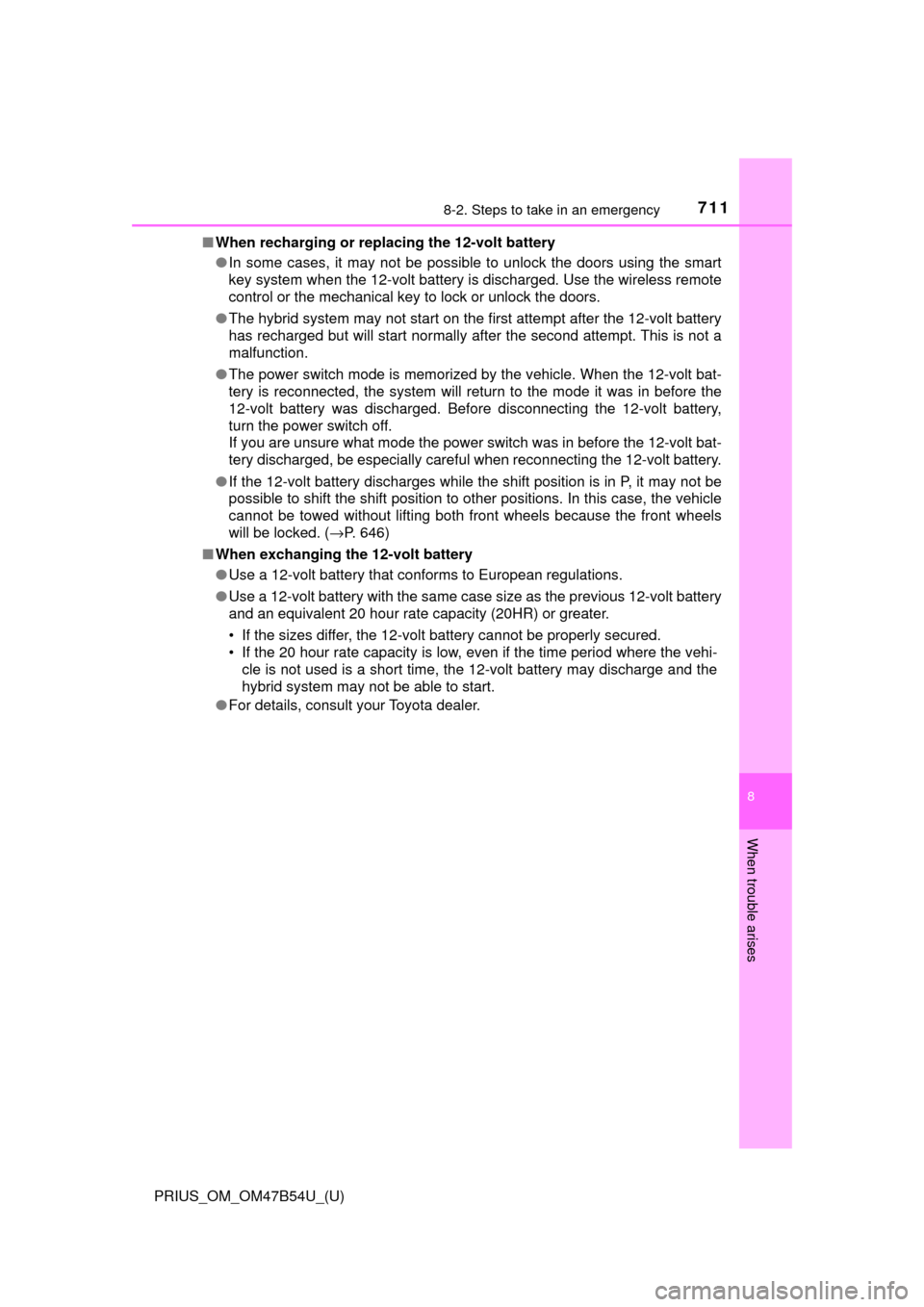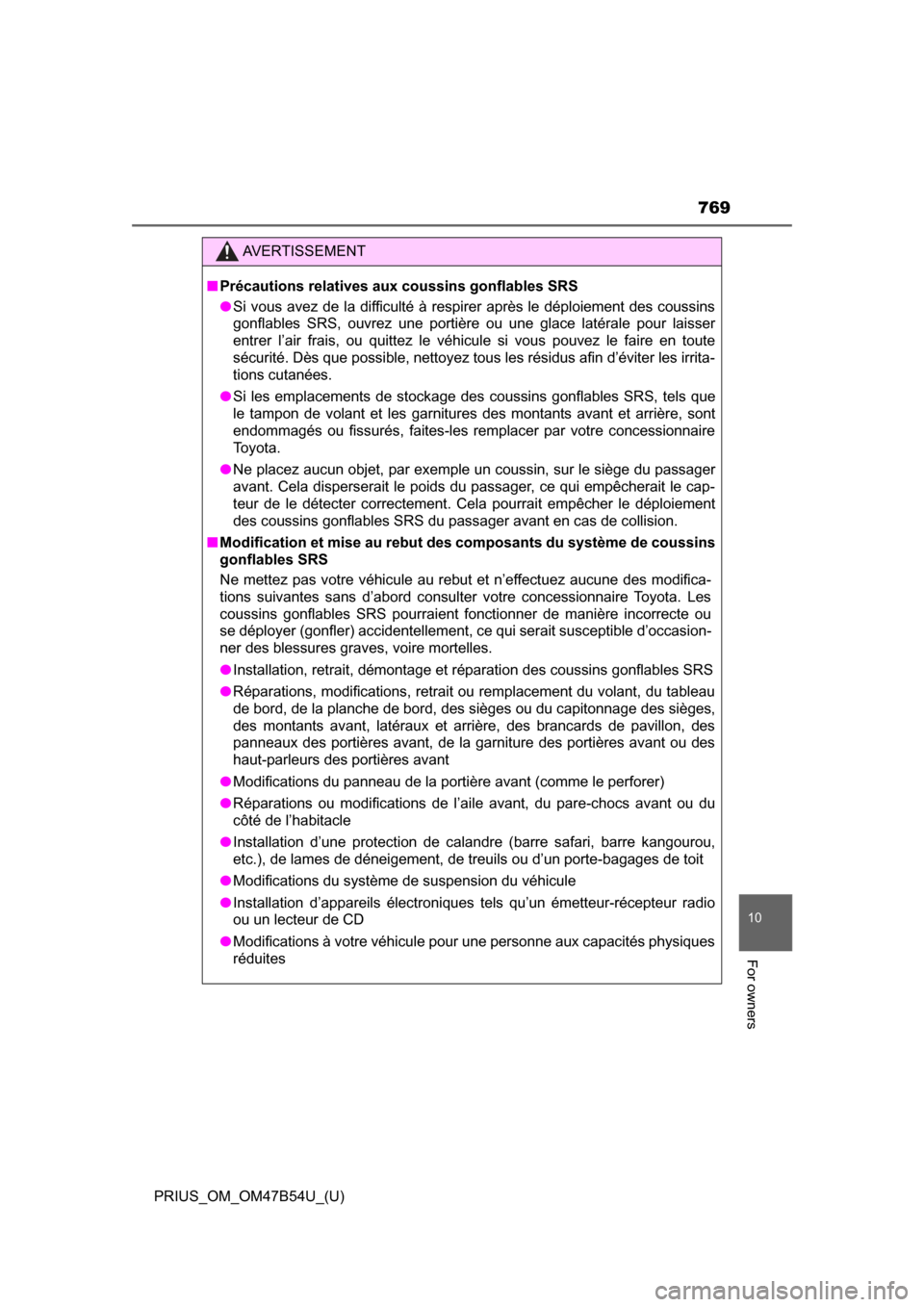2017 TOYOTA PRIUS ESP
[x] Cancel search: ESPPage 669 of 796

6698-2. Steps to take in an emergency
PRIUS_OM_OM47B54U_(U)
8
When trouble arises
■If “Maintenance Required Visit Your Dealer” is displayed (U.S.A. only)
Indicates that all maintenance is required to correspond to the driven distance
on the maintenance schedule
*.
Comes on approximately 5000 miles (8000 km) after the message has been
reset. (The indicator will not work properly unless the message has been
reset.)
Perform the necessary maintenance. Please reset the message after the
maintenance is performed. ( →P. 578)
*: Refer to the separate “Scheduled Maintenance Guide” or “Owner’s Manual
Supplement” for the maintenance interval applicable to your vehicle.
■ If the shift position cannot be changed or the power switch is turned to
ACCESSORY mode even if trying to turn the power switch off when a
warning message is shown
If the 12-volt battery is discharged or the shift control system is malfunction-
ing, the followings may occur.
● The shift position may not be changed to P.
When parking, stop the vehicle on level ground and apply the parking brake
firmly.
● The hybrid system may not start.
● The power switch may be turned to ACCESSORY mode even if trying to
turn the power switch off.
In this case, the power switch may be turned off after applying the parking
brake.
● The automatic P position selection function ( →P. 237) may not operate.
Before turning the power switch off, be sure to press the P position switch
and check that the shift position is in P by the shift position indicator or P
position switch indicator.
■ Warning buzzer
→P. 659
NOTICE
■If “Have Traction Battery Inspected” is shown
The hybrid battery (traction battery) is scheduled to be inspected or
replaced. Have the vehicle inspected by your Toyota dealer immediately.
● Continuing to drive the vehicle without having the hybrid battery (traction
battery) inspected will cause the hybrid system not to start.
● If the hybrid system does not start, contact your Toyota dealer immedi-
ately.
Page 701 of 796

7018-2. Steps to take in an emergency
PRIUS_OM_OM47B54U_(U)
8
When trouble arises
WARNING
■Driving to spread the liquid sealant evenly
Observe the following precautions to reduce the risk of accidents.
Failing to do so may result in a loss of vehicle control and cause death
or serious injury.
●Drive the vehicle carefully at a low speed. Be especially careful when
turning and cornering.
●If the vehicle does not drive straight or you feel a pull through the
steering wheel, stop the vehicle and check the following.
• Tire condition. The tire may have separated from the wheel.
• Tire inflation pressure. If the tire inflation pressure is 19 psi (130 kPa, 1.3 kgf/cm
2 or bar) or less, the tire may be severely dam-
aged.
NOTICE
■When performing an emergency repair
●A tire should only be repaired with the emergency tire puncture repair
kit if the damage is caused by a sharp object such as nail or screw
passing through the tire tread.
Do not remove the sharp object from the tire. Removing the object may
widen the opening and disenable emergency repair with the repair kit.
●The repair kit is not waterproof. Make sure that the repair kit is not
exposed to water, such as when it is being used in the rain.
●Do not put the repair kit directly onto dusty ground such as sand at the
side of the road. If the repair kit vacuums up dust etc., a malfunction
may occur.
■Precautions for the emergency tire puncture repair kit
●The repair kit power source should be 12 V DC suitable for vehicle
use. Do not connect the repair kit to any other source.
●If fuel splatters on the repair kit, the repair kit may deteriorate. Take
care not to allow fuel to contact it.
●Place the repair kit in a storage to prevent it from being exposed to dirt
or water.
●Store the repair kit in the luggage compartment out of reach of chil-
dren.
●Do not disassemble or modify the repair kit. Do not subject parts such
as the air pressure indicator to im pacts. This may cause a malfunction.
Page 711 of 796

7118-2. Steps to take in an emergency
PRIUS_OM_OM47B54U_(U)
8
When trouble arises
■When recharging or repl acing the 12-volt battery
● In some cases, it may not be possible to unlock the doors using the smart
key system when the 12-volt battery is discharged. Use the wireless remote
control or the mechanical key to lock or unlock the doors.
● The hybrid system may not start on the first attempt after the 12-volt battery
has recharged but will start normally after the second attempt. This is not a
malfunction.
● The power switch mode is memorized by the vehicle. When the 12-volt bat-
tery is reconnected, the system will return to the mode it was in before the
12-volt battery was discharged. Before disconnecting the 12-volt battery,
turn the power switch off.
If you are unsure what mode the power switch was in before the 12-volt bat-
tery discharged, be especially careful when reconnecting the 12-volt battery.
● If the 12-volt battery discharges while the shift position is in P, it may not be
possible to shift the shift position to other positions. In this case, the vehicle
cannot be towed without lifting both front wheels because the front whee\
ls
will be locked. ( →P. 646)
■ When exchanging the 12-volt battery
●Use a 12-volt battery that conforms to European regulations.
● Use a 12-volt battery with the same case size as the previous 12-volt battery
and an equivalent 20 hour rate capacity (20HR) or greater.
• If the sizes differ, the 12-volt battery cannot be properly secured.
• If the 20 hour rate capacity is low, even if the time period where the vehi-
cle is not used is a short time, the 12-volt battery may discharge and the
hybrid system may not be able to start.
● For details, consult your Toyota dealer.
Page 717 of 796

7178-2. Steps to take in an emergency
PRIUS_OM_OM47B54U_(U)
8
When trouble arises
After stopping the hybrid system and waiting for 5 minutes or
more, start the hybrid system again and check if “Hybrid System
Overheated” is shown on the multi-information display.
If the message does not disappear:
Stop the hybrid system and contact your Toyota dealer.
If the message is not displayed:
The hybrid system temperature has dropped and the vehicle may
be driven normally.
However, if the message appears again frequently, contact your Toyota
dealer.
WARNING
■ To prevent an accident or injury when inspecting under the hood of
your vehicle
Observe the following precautions.
Failure to do so may result in serious injury such as burns.
● If steam is seen coming from under the hood, do not open the hood until
the steam has subsided. The engine compartment may be very hot.
● After the hybrid system has been turned off, check that the “Accessory”,
“Ignition ON” or mileage display ( →P. 108) on the main display and the
“READY” indicator are off.
When the hybrid system is operating, the gasoline engine may automati-
cally start, or the cooling fans may suddenly operate even if the gasoline
engine stops. Do not touch or approach rotating parts such as the fan,
which may lead to fingers or clothing (especially a tie, a scarf or a muffler)
getting caught, resulting in serious injury.
● Do not loosen the coolant reservoir caps while the hybrid system and radi-
ator are hot.
High temperature steam or coolant could spray out.
6
Page 741 of 796

PRIUS_OM_OM47B54U_(U)
7419-1. Specifications
9
Vehicle specifications
■Temperature A, B, C
The temperature grades are A (the highest), B, and C, representing
the tire’s resistance to the generation of heat and its ability to dissi-
pate heat when tested under co ntrolled conditions on a specified
indoor laboratory test wheel.
Sustained high temperature can c ause the material of the tire to
degenerate and reduce tire life, and excessive temperature can lead
to sudden tire failure.
Grade C corresponds to a level of performance which all passenger
car tires must meet under the Federal Motor Vehicle Safety Stan-
dard No. 109.
Grades B and A represent higher levels of performance on the labo-
ratory test wheel than the minimum required by law.
Warning: The temperature grades of a tire assume that it is properly
inflated and not overloaded.
Excessive speed, underinflation, or excessive loading, either sepa-
rately or in combination, can cause heat buildup and possible tire
failure.
Page 769 of 796

PRIUS_OM_OM47B54U_(U)
769
10
For owners
AVERTISSEMENT
■Précautions relatives aux coussins gonflables SRS
● Si vous avez de la difficulté à respirer après le déploiement des coussins
gonflables SRS, ouvrez une portière ou une glace latérale pour laisser
entrer l’air frais, ou quittez le véhicule si vous pouvez le faire en toute
sécurité. Dès que possible, nettoyez tous les résidus afin d’éviter les irrita-
tions cutanées.
● Si les emplacements de stockage des coussins gonflables SRS, tels que
le tampon de volant et les garnitures des montants avant et arrière, sont
endommagés ou fissurés, faites-les remplacer par votre concessionnaire
Toyota.
● Ne placez aucun objet, par exemple un coussin, sur le siège du passager
avant. Cela disperserait le poids du passager, ce qui empêcherait le cap-
teur de le détecter correctement. Cela pourrait empêcher le déploiement
des coussins gonflables SRS du passager avant en cas de collision.
■ Modification et mise au rebut des composants du système de coussins
gonflables SRS
Ne mettez pas votre véhicule au rebut et n’effectuez aucune des modifica-
tions suivantes sans d’abord consulter votre concessionnaire Toyota. Les
coussins gonflables SRS pourraient fonctionner de manière incorrecte ou
se déployer (gonfler) accidentellement, ce qui serait susceptible d’occasion-
ner des blessures graves, voire mortelles.
● Installation, retrait, démontage et réparation des coussins gonflables SRS
● Réparations, modifications, retrait ou remplacement du volant, du tableau
de bord, de la planche de bord, des sièges ou du capitonnage des sièges,
des montants avant, latéraux et arrière, des brancards de pavillon, des
panneaux des portières avant, de la garniture des portières avant ou des
haut-parleurs des portières avant
● Modifications du panneau de la portière avant (comme le perforer)
● Réparations ou modifications de l’aile avant, du pare-chocs avant ou du
côté de l’habitacle
● Installation d’une protection de calandre (barre safari, barre kangourou,
etc.), de lames de déneigement, de treuils ou d’un porte-bagages de toit
● Modifications du système de suspension du véhicule
● Installation d’appareils électroniques tels qu’un émetteur-récepteur radio
ou un lecteur de CD
● Modifications à votre véhicule pour une personne aux capacités physiques
réduites